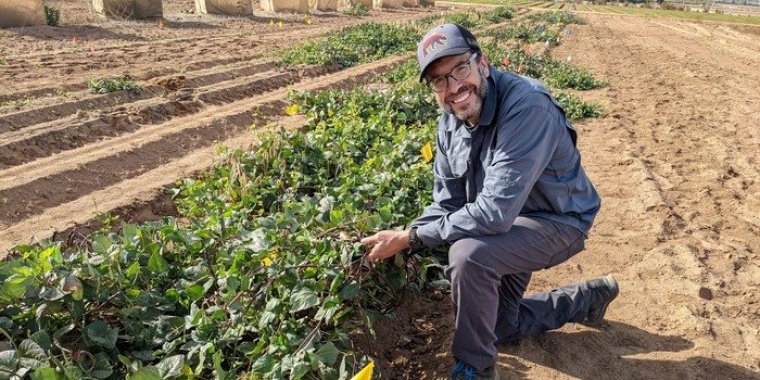| News / Science News |
Black-eyed peas could help eliminate need for fertilizer
The ability of black-eyed peas to attract beneficial bacteria isn't diminished by modern farming practices, new research from the University of California, Riverside shows. Planting the peas in rotation with other crops could help growers avoid the need for costly, environmentally damaging fertilizers.

Evolutionary biologist Joel Sachs conducting research on black-eyed peas in a fertilizer study. Photo: UCR
Without enough nitrogen, plants won't grow. The plant family black-eyed peas belong to, the legumes, is unique in its ability to obtain substantial amounts of nitrogen by enticing and protecting nitrogen-fixing bacteria.
"This ability of legumes led to their success as the third biggest plant family on the planet," said evolutionary biologist Joel Sachs of UC Riverside.
When farmers grow crops, they often focus on above-ground traits such as disease resistance, yield and protein content.
Only recently have growers begun to pay closer attention to below-ground traits, such as the ability of plants to attract soil-enhancing microbes.
In many cases, plants heavily impacted by humans do not benefit as much from relationships with bacteria as their wild relatives.
UC Riverside plant pathologist Gabriel Ortiz wanted to know whether black-eyed peas -- a popular food in many parts of the world -- maintain their ability to attract good bacteria even after being subjected to modern farming practices.
Ortiz and his team found that the peas maintained their natural ability to form beneficial relationships with nitrogen-fixing bacteria.
"In fact, some of the strains appear to have gained more benefit from bacteria than their wild ancestors," Sachs said.
Experiments involving 20 different types of black-eyed peas point toward a genetic basis for their symbiotic abilities.
"We can use this information to design better-performing plants," Ortiz said. The team focused on black-eyed peas because they are also drought-tolerant, an important trait for Southern California growers. (National Science Foundation)





